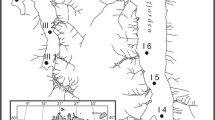Abstract
Former sand-mining pits at Capel, 200 km south of Perth in Western Australia, have been rehabilitated into artificial wetlands since 1975–1979. A chain of fresh water lakes was created as a potential waterbird refuge and an area for passive recreation. Initially, the lakes had low pH, high ammonium, iron and manganese levels and low phosphorus concentration. The lakes were characterised by low diversity of diatoms dominated by acidophilous species. Following an increase in pH in the effluent water discharged into the lake from the mining process plant and landscaping of the lakes since 1988, the diversity of diatoms gradually increased. The system is now dominated by periphytic diatom communities, preferring high conductivity. There has been a marked transition in the diatom community from acidophilous to alkaliphilous species. Planktonic diatom blooms replaced dinoflagellate blooms. Concomitantly, there has been a dramatic increase in the diversity of invertebrates and waterbirds in these lakes. The value of diatoms in assessing the progressive development of created wetlands as self-sustaining ecosystems at sand mines in Australia is discussed.
Similar content being viewed by others
References
Abel, P.O., 1988. Water Pollution Biology. Ellis Harwood Ltd., New York, 231 pp.
Battarbee, R.W., N.J. Anderson, P.G. Appleby, R.J. Flower, S.C. Fritz, E.Y. Haworth, S. Higgitt, V.J. Jones, A. Kreiser, M.A.R. Munro, J. Natkanski, F. Oldfield, S.T. Patrick, N.J. Richardson, B. Rippey & A.C. Stevenson, 1988. Lake acidification in the United Kingdom 1800–1986. Evidence from analysis of lake sediments. ENSIS Publishing, London, 68 pp.
Brugam, R.B. & M. Lusk, 1986. Diatom evidence for neutralization in acid surface mine lakes. In J. Smol, R.W. Battarbee, R.B. Davis & J. Meriläinen (eds), Diatoms and lake acidity, Dr W. Junk Publishers, Dordrecht: 115–129.
Cassie, V., 1989. A contribution to the study of New Zealand diatoms. Bibliotheca Diatomologica 17: 1–226.
Compère, P., 1986. Diatoms in two hot springs in Zambia (Central Africa). In F.E. Round (ed.), Proceedings of the 9th International Diatom Symposium, Biopress, Bristol and O. Koeltz, Koenigstein: 29–39.
Cox, E.J., 1991. What is the basis for using diatoms as monitors of river quality? In B.A. Whitton, E. Rott & G. Friedrich (eds), Use of algae for monitoring rivers. E. Rott, Innsbruck: 33–40.
Eloranta, P., 1990. Ecology of some acidophilic and acidobiontic diatoms in Finnish forest lakes. In Simola, H. (ed.), Proceedings of the Tenth International Diatom Symposium. Koeltz, Scientific Books, Koenigstein, 491–498.
Foged, N., 1978. Diatoms in Eastern Australia. Bibliotheca Phycologica 41: 1–232.
Fungladda, N., I. Kaczmarska, & S.R. Rushforth, 1983. A contribution to the freshwater diatom flora of the Hawaiian Islands. Bibliotheca Diatomologica 2: 1–103.
Gasse, F., 1986. East African diatoms and water pH. In J.P. Smol, R.W. Battarbee, R.B. Davis, and J. Meriläinen (eds). Diatoms and lake acidity. Dr W. Junk Publishers, Dordrecht: 149–168.
Hammer, D.A., 1992. Creating freshwater wetlands. Lewis Publishers Inc., U.S.A.: 298 pp.
Hustedt, F., 1959. Die Kieselalgen Deutschlands, Österreichs und der Schweiz. In Dr. L. Rabenhorst's Kryptogamen flora von Deutschlands, Österreichs und der Schweiz 7(2). Reprint 1977, Otto Koeltz, Koenigstein: 440–574.
Johansen, J.R. & S.R. Rushforth, 1985. A contribution to the taxonomy of Chaetoceros muelleri Lemmermann (Bacillariophyceae) and related taxa. Phycologia 24: 437–447.
John, J., 1983. Diatom flora of the Swan River estuary, Western Australia. Bibliotheca Phycologica 64: 1–360.
Kelly, M., 1988. Mining and the freshwater environment. Elsevier Applied Science, London, 231 pp.
Krammer, K. & H. Lange-Bertalot, 1986. Bacillariophyceae. Süsswasserflora von Mitteleuropa 2(1). Gustav-Fischer Verlag. Stuttgart, 876 pp.
Lowe, R.L., 1974. Environmental requirements and pollution tolerance of freshwater diatoms. U.S. EPA, Cincinnati, Ohio, 334 pp.
Patrick, R. & C.W. Reimer, 1966–1975. The diatoms of the United States. Monogr. Acad. Nat. Sc. Phila., No. 13, Part 1, 1–2.
Patrick, R., 1986. Diatoms as indicators of changes in water quality. In M. Ricard (ed.), Proceedings of the 8th International Diatom Symposium. Koeltz Scientific Books, Koenigstein: 759–766.
Round, F.E., 1986. Non-planktonic diatoms and acid lakes. In M. Ricard (ed.), Proceedings of the 8th International Diatom Symposium. Koeltz Scientific Books, Koeningstein: 753–755.
Round, F.E., 1990. The effect of liming on the benthic diatom populations in three upland Welsh lakes. Diatom Res. 5: 129–140.
Schoeman, F.R., 1973. A systematical and ecological study of the diatom flora of Lesotho with special reference to the water quality. National Institute of Water Research, South Africa, 354 pp.
Sullivan, M.J., 1986. Mathematical expression of diatom results: Are these pollution indices valid and useful? In M. Ricard Proceedings of the 8th International Diatom Symposium, Koeltz Scientific Books, Koenigstein: 772–775.
Van Dam, H., 1982. On the use of measures of structure and diversity in applied diatom ecology. Nova Hedwigia, Beih. 73: 97–115.
Author information
Authors and Affiliations
Rights and permissions
About this article
Cite this article
John, J. The use of diatoms in monitoring the development of created wetlands at a sandmining site in Western Australia. Hydrobiologia 269, 427–436 (1993). https://doi.org/10.1007/BF00028040
Issue Date:
DOI: https://doi.org/10.1007/BF00028040




